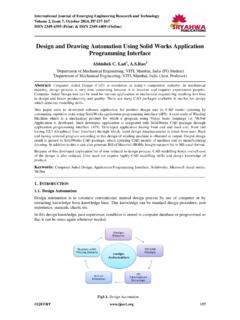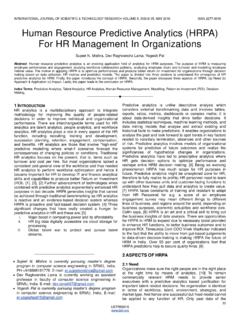Transcription of 'Big Data': Big Gaps of Knowledge in the field of Internet ...
1 international journal of Internet Science 2012, 7 (1), 1 5 ISSN 1662-5544 Big data : Big gaps of Knowledge in the field of Internet Science Chris Snijders1, Uwe Matzat1, Ulf-Dietrich Reips2,3 1 Eindhoven University of Technology, The Netherlands, 2 University of Deusto, Spain, 3 IKERBASQUE, Basque Foundation for Science, Spain As a member of the editorial board and editors of the international journal of Internet Science we would like to take this opportunity to comment on some interesting developments in the field of Internet science and Web science. The analysis of so-called Big data has received a remarkable momentum. Conducting a search with Big data as a query, we find 130 entries in the ISI Web of Science, as of July 12.
2 Of these, 94 publications have appeared since 2008, which is no surprise because before 2008 there was no terminological consensus. For 2008 through 2011 the number of publications in the ISI Web of Science equals 16, 16, 13, and 26. In the first half of 2012 (July 12), we find 23 publications for just the first six months, suggesting a rapid future increase. As we explain below, this stream of research has provided useful insights, but also suffers from some serious limitations. The interesting point is that these limitations can (and have to) be addressed by theory guided research that is typically conducted by social scientists. Accordingly, opportunities emerge for those social and behavioral scientists who are willing to collaborate with the Big data researchers in the natural, engineering, and computer sciences .
3 While this short editorial does not claim to provide an exhaustive overview of Big data research we hope that it contributes to clarifying what type of questions and problems need input from the social and behavioral sciences . We have the feeling that these Knowledge gaps have not yet received the attention they deserve, and would certainly welcome submissions along these lines in this journal . What we know Big data is a loosely defined term used to describe data sets so large and complex that they become awkward to work with using standard statistical software. The rise of digital and mobile communication has made the world become more connected, networked, and traceable and has typically lead to the availability of such large scale data sets (Rainie & Wellman, 2012).
4 Some of the keepers of Big data sets develop interfaces for everyone to access and analyze some of the data , Google provides freely available Google Insights, while others hesitate to offer any access. Scientists have begun to develop Web services with interfaces to collectors of Big data sets, , Milne and Witten (2009) for Wikipedia at and Reips and Garaizar (2011) for Twitter at In this editorial, we focus on the stream of Big data analysis that considers different kinds of online (and offline) networks. Analyses of different kinds of networks have shown that in many empirical networks the distribution of the degrees of the nodes follows a power-law ( , Barabasi, Albert, & Jeong, 2000). Another network Address correspondence to Chris Snijders, Eindhoven University of Technology, PO Box 513, 5600 MB Eindhoven, The Netherlands, and the international journal of Internet Science, The author(s) would like to acknowledge the contribution of the COST Action IS1004 "WEBDATANET" ( ).
5 Updated second version, available since February 9, 2013. Previous version available from Snijders et al. / international journal of Internet Science 7 (1), 1 5 2 characteristic that has received a lot of attention is the extent to which a network can be considered small world : pairs of nodes have a low shortest path length between them and the network as a whole is typically organized as a set of dense but loosely connected clusters (Watts & Strogatz, 1998). More recent findings include dynamic properties of networks such as whether networks have a constant average degree (the number of edges growing linearly with the number of nodes) or whether the diameter of the network decreases over time.
6 The empirical networks under study range from the World Wide Web (Barabasi, Albert, & Jeong, 2000), science citation networks (Leskovec, Kleinberg, & Faloutsos, 2007), sexual relationships (Liljeros et al., 2001), to telephone networks (Cortes & Pregibon, 2001). Given such often observed empirical regularities, several micro-models have been suggested that might lead to networks with the desired properties as suggested above. Some well known models are the Erdos-R nyi random graph model (Erdos & R nyi, 1959), the small-world model (Watts & Strogatz, 1998), preferential attachment (Price, 1976; Yule, 1925), the edge copying model (Kleinberg et al., 1999), and community guided attachment and forest fire models (Leskovic, Kleinberg, & Faloutsos, 2007).
7 Research in this area shows, for instance, that when we assume that each new node connects to existing nodes with a probability that is proportional to the degree of the existing node the key assumption in the preferential attachment model that one then indeed ends up with networks that have degree distributions that follow a power law. The underlying logic is compelling: if we find that many real world networks have property X, let us try to understand which processes could lead to property X. What we do not know: social science theories as guidance for the analysis of micro-processes leading to macro-outcomes A crucial problem is that we do not know much about the underlying empirical micro-processes that lead to the emergence of these typical network characteristics of Big data .
8 Most of the underlying process models at the node level are inspired by mathematical ease of exposition, tractability or quite crude approximations of what could really be going on. For instance, the basic preferential attachment model assumes that existing nodes do not connect to each other at all (no new ties between those already in the network). This, however, is a strong assumption that has never been tested adequately to find out whether its violation leads to divergent outcomes at the macro-level of the whole network. Instead of trying to find micro-processes that lead to certain aggregate network properties based on mathematical tractability, one could follow a different analytical strategy and try to come up with micro-processes that match with actual behavior.
9 And this is exactly where social and behavioral research can play its role. To gain Knowledge about the underlying micro-processes social scientists could consider several (online) social networks and measure the process of tie-formation in more detail, derive network micro-foundations from these measurements, and then consider the network properties that follow from it. It is unclear whether this is possible for all types of online networks, but there are certainly more than enough opportunities to consider. For instance, the micro-processes of blog networks and the micro-processes of posting behavior within Knowledge sharing online communities (such as emailing lists) lend themselves to such an approach. Both types of networks have been objects of mathematical modeling (Cointet & Roth, 2009; Goetz et al, 2009).
10 However, it is unclear whether, and if so, to what extent the models' assumptions rest on realistic mechanisms that take place at the micro level during the tie-formation, and the suggested approach would complement the mathematical method perfectly. The crucial addition to the literature rests in the fact that such an approach utilizes not only the data on nodes and their interconnections. In addition, survey and interview data about characteristics of the actors and the characteristics of the online community as a whole can be collected and combined with the online data . As the starting point for such an endeavor, one could consider empirical sociological and social-psychological analyses of processes of tie-formation and bring these back to a limited number of behavioral mechanisms, such as homophily of different kinds, reciprocity, scope of access to other nodes, etc.






